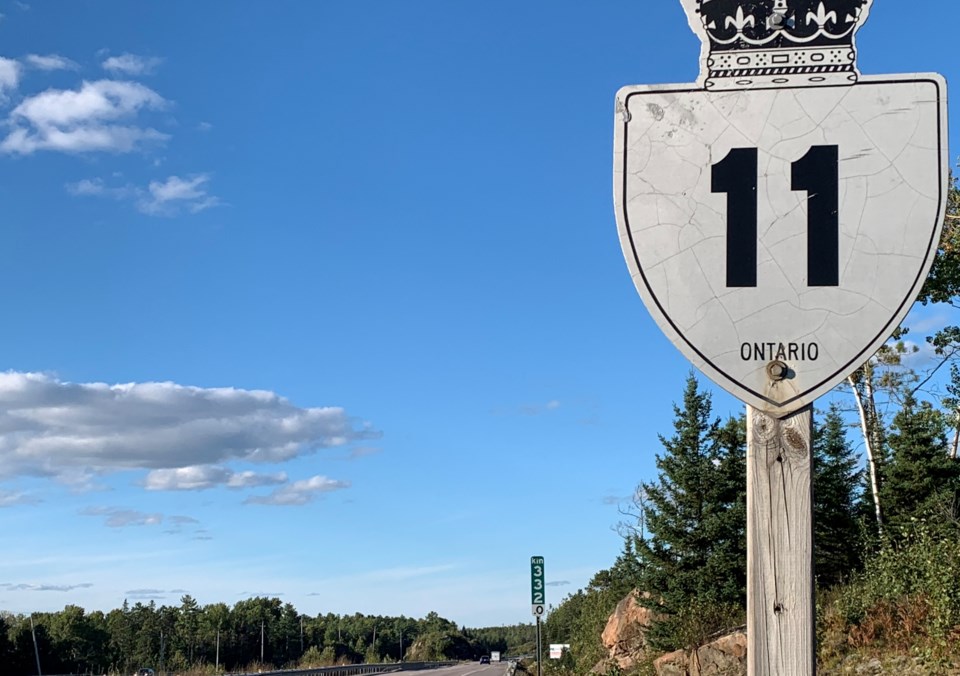A pilot project south of North Bay on Highway 11 that raised the speed limit from 100 to 110 has now been made permanent says the MTO.
In 2022, MTO raised the speed limit permanently to 110 km/h on several sections of highways, as well as two trial sections in northern Ontario, one being a section near South River.
"Since the change in speed limit, MTO has determined that these sections of highways continue to operate as expected without a significant increase in collisions or operating speeds," Tanya Blazina of the Ministry of Transportation told BayToday. "As a result, the Highway 11 section from Emsdale to South River will remain at 110 km/h on a permanent basis."
See: Highway 11 near South River will see speed limit increase
MTO did not respond to a question about whether other sections of Highway 11 would have speed limits increased.
A survey in 2020 indicated the public is in favour of increased limits.
"People are telling us loud and clear that they support a safe and moderate increase to speed limits on these highways," said Caroline Mulroney, Minister of Transportation. "The increased speed limit pilot is just one way that our government is improving our transportation network — bringing it in line with other jurisdictions to get people where they need to go when they want to get there."
More than 8,300 people responded to the survey.
This week the Ontario government raised the speed limit permanently from 100 km/h to 110 km/h on 10 additional sections of provincial highways in northern and southern Ontario. "The change builds on the safe and successful increase to six sections of provincial highways in 2022 and aligns with posted speed limits in other jurisdictions across Canada," says an MTP release.
See: Raising speed limits on Ontario highways
“Most of Ontario’s highways were originally designed to safely accommodate speed limits of 110 km/h and the data from our changes in 2022 shows they do just that,” said Prabmeet Sarkaria, Minister of Transportation. “These evidence-based increases are a common-sense change to make life more convenient for Ontario drivers while bringing our highway speed limits in line with other Canadian provinces.”
Starting immediately the speed limit will be permanently raised to 110 km/h on most of the following provincial highway sections, with the remainder coming into force before the end of the year:
- Hwy 69 from Sudbury to French River (approximately 60 km)
- Hwy 401, Tilbury, extending the existing 110 km/h zone further east by 7 km
- Hwy 401 from Hwy 35/115 to Cobourg (approximately 35 km)
- Hwy 401 from Colborne to Belleville (approximately 44 km)
- Hwy 401 from Belleville to Kingston (approximately 66 km)
- Hwy 401 from Hwy 16 to Quebec boundary (approximately 107 km)
- Hwy 403 from Woodstock to Brantford (approximately 26 km)
- Hwy 403 from Brantford to Hamilton (approximately 14.5 km)
- Hwy 406 from Thorold to Welland (approximately 13 km)
- Hwy 416 from Hwy 401 to Ottawa (approximately 70 km)
All highway sections were selected based on their ability to safely accommodate higher speed limits. Alberta, Manitoba, New Brunswick, Nova Scotia and Saskatchewan have a maximum speed limit of 110 km/h, while in British Columbia, the maximum speed limit is 120 km/h.
In 2019, the Ontario government launched consultations and a pilot program to explore opportunities to safely increase speed limits on select Ontario highways.
In 2022, the government permanently increased the speed limit on six sections of provincial highways in southern Ontario as well as two sections in northern Ontario on a two-year trial basis.
The permanent increase in speed from 100km/h to 110km/h will cover 36 per cent and 860 kilometres of Ontario’s highway network.
Stunt driving penalties will continue to apply at 150 km/h. On the highway sections with increased speed limits, stunt driving penalties will apply at 40 km/h over the posted speed limit.



